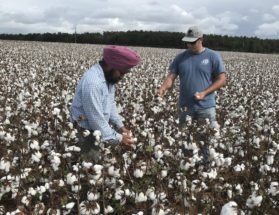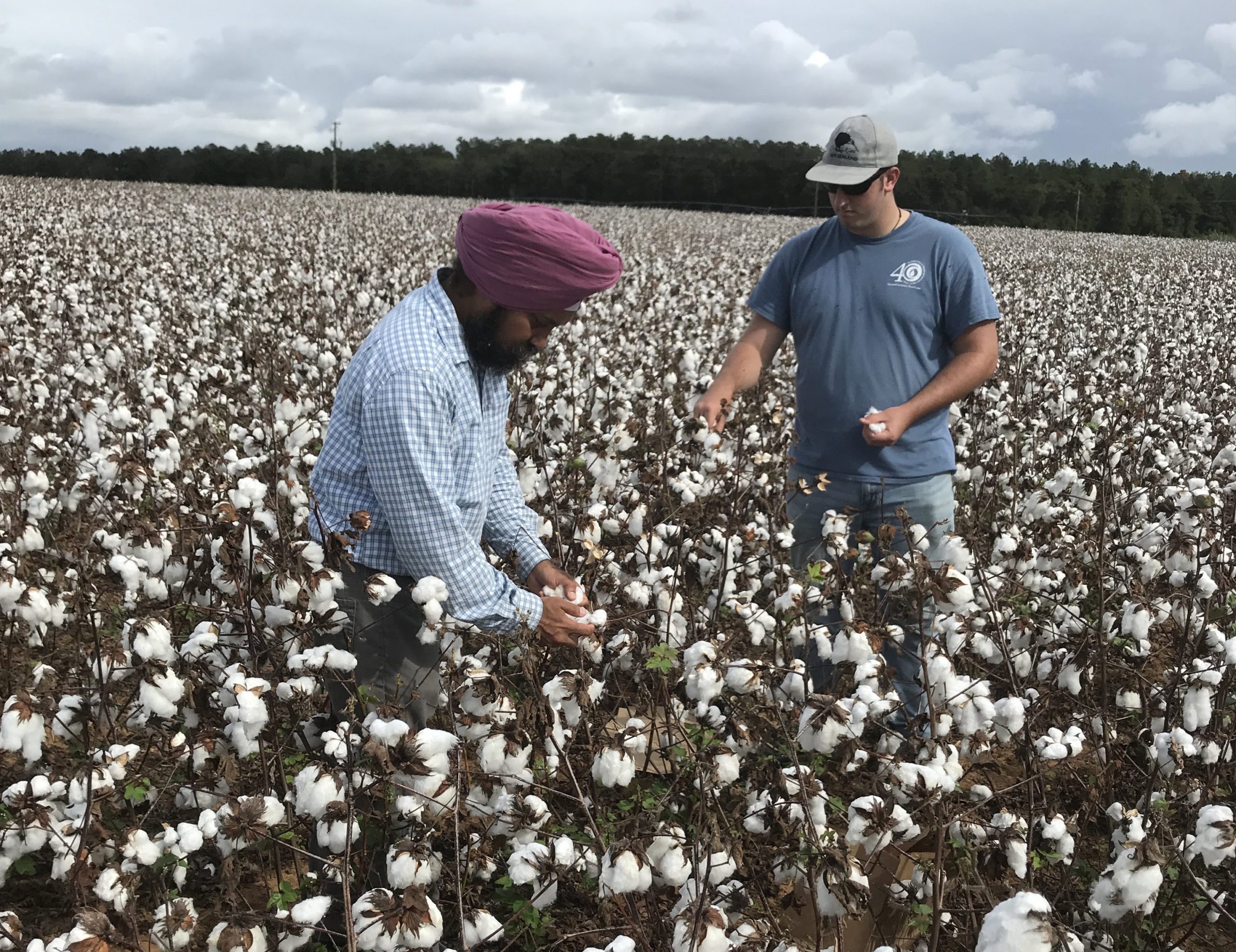BLACKVILLE, S.C. – Earth’s population is expected to increase by more than 2 billion people by 2050 and, to help ensure there is enough food and fiber to go around, keeping soils healthy is crucial.
Bhupinder Farmaha, a soil nutrient management specialist at Clemson’s Edisto Research and Education Center (REC), believes utilizing cover crops and conservation tillage in cotton may be just what the doctor ordered for healthy soils.
Farmaha has received a $500,000 grant from the United States Department of Agriculture Natural Resources Conservation Service (USDA-NRCS) to help prove his theory.

“In the last century, U.S. agriculture has seen a big shift from highly diversified low-input agricultural production systems to highly specialized systems that dramatically increase yields with intensive use of synthetic fertilizers,” Farmaha said. “Despite record yields in recent years, the farm profitability of production agriculture in the U.S. is stressed due to low commodity prices and increases in fertilizer costs. For this reason, there has been a gradual decline in acreage in cropland and pastureland.
“In order to fulfill our commitment to a sustainable future and ensure food security for a growing global population, we need to restore and enhance soil health that supports agriculture production.”
Three common strategies — conservation tillage, diversified crop rotations and cover crops — are used to improve soil health. This project will take place on farms in South Carolina and North Carolina, including farms owned by historically underserved producers, to address how adopting conservation management practices can help Carolina cotton conserve soil.
To participate in this research, farms must be eligible for the USDA-NRCS Environmental Quality Incentives Program (EQUIP), a voluntary conservation program that helps producers implement conservation programs on their farms.
During the project, researchers will: evaluate soil health impacts by implementing conservation management practices either through winter cover crops, minimal tillage, diversified rotations, and using organic inputs in on-farm trials; show other growers the use, challenges, benefits and effectiveness of implementing conservation management practices, and evaluate agronomic-socio-economic-environmental impacts of using these practices. They also will train crop advisors, Cooperative Extension Service agents, seed dealers and USDA-NRCS personnel who will help growers learn about and adopt these practices in the future.
Collaboration across the cotton spectrum
In addition to Clemson researchers and participating farmers, other entities involved with the project include the Clemson Cooperative Extension Service, North Carolina State University, USDA-NRCS, Soil and Water Conservation Districts, the South Carolina Cotton Board and Cotton Incorporated. Gaylon Morgan, director of Agricultural and Environmental Research for Cotton Incorporated, said collaborations such as this are important.

“The Coastal Plains of the Carolinas is a very important cotton production region with around 750,000 acres reported in 2020,” Morgan said. “The vast majority of row crop acres are non-irrigated and the soils have relatively low water holding capacity. With low adoption of soil health practices, more erratic and intensive rainfall events, on-farm research and outreach efforts on reduced tillage and cover crops are needed to mitigate risks and help ensure grower profitability.”
The cotton industry has set sustainability goals which include a 50% reduction in soil loss, a 30% increase in soil carbon and a 39% decrease in greenhouse gas emissions by 2028. Research shows growing cover crops and using reduced tillage are two key management strategies needed to reach these goals. Officials are monitoring adoption of sustainability practices through data collected as part of the U.S. Cotton Trust Protocol.
“On-farm research and outreach efforts are critical to demonstrating the value of utilizing reduced tillage and cover cropping systems in the Carolinas,” Morgan said.
These trials can help growers make better, more informed decisions, said Terry Kelly, USDA-NRCS state resource conservationist.
“On-farm trials will grow producers’ confidence to make changes on their farms,” Kelly said. “In addition, on-farm trial results, data and field history information summarized for easy understanding will be discussed in the context of growers’ knowledge about their farms, fields and practices. The updated research data can be disseminated to other producers it the area or region as a result of these trials.”
Kelly said collaborating with Clemson and North Carolina State University is a strategic approach that supports the mission of NRCS by promoting agricultural production to address ecological risks across different agricultural production systems, ownership boundaries, and landscape types to have direct and positive effects on land management practices and rural economies, as well as the people in North and South Carolina.
“This collaborative effort shall result in the preserving our nation’s natural resources through conservation, improved watersheds, healthy private working lands, and provide economic opportunity through innovation,” he said. “A key component to promoting sustainable agriculture is the use of the best available science, a product of Land Grant University unbiased research-based information and education disseminated through Extension staff.”
Alan Franzluebbers of the USDA and Steve Broome of North Carolina State University lead the North Carolina research. They bring to the project experience in soil health analysis and working with growers to achieve successful demonstrations of on-farm trials.
“We have conducted research with corn growers we believe will be applicable to cotton growers as well,” Franzluebbers said. “The partnership between USDA-Agricultural Research Service and North Carolina State University has been effective and we work with other partners to find ways to promote conservation and develop sound science-based information. We see the potential to improve soil health in cotton production systems, and this research and demonstration project offers a good opportunity to share our collective expertise.
“We believe that participating in team research to serve farming and broader society goals is part of our mission and duty as publicly-funded scientists.”
Farmaha agrees.
“As a land grant institution, it is our responsibility to provide growers with research-based information to help them grow profitable crops,” he said. “Collaborating with researchers from other institutions who have expertise in other areas allows us to expand our efforts and increase our ability to help more producers. It is our intent to rapidly deploy techniques learned from this research throughout grower and consultant communities by directly involving them in testing, outreach and other project activities.”
Research such as this is needed to ensure people have enough food and fiber for the future. A report from the United Nations projects the Earth’s population to reach 9.8 billion people by 2050, an increase of more than 2 billion as compared to the 7.6 billion people on Earth today.
“Knowledge gained from this research will help build a sustainable future for agriculture to help meet the needs of people today and in the future,” Farmaha said.
In addition to this grant, Farmaha also is lead researcher for another study with Cotton Incorporated that involves predicting cotton yields in response to nitrogen applications. He also is working on another USDA-NRCS-funded project to evaluate the use of cover crops on cotton nitrogen and potassium fertility, economic profits and soil health.
-END-
This study is funded by the United States Department of Agriculture Natural Resources Conservation Service (USDA-NRCS) CU Award 0183-207-2024535. Any opinions, findings, and conclusions, or recommendations expressed in this material are those of the authors and do not necessarily reflect the views of the USDA-NRCS.
Get in touch and we will connect you with the author or another expert.
Or email us at news@clemson.edu

